Introduction
Conference microphone systems, or push-to-talk or discussion systems, are used in settings like boardrooms, classrooms, and government meetings to help participants communicate clearly. Each person gets a microphone and speaker to hear and speak to others easily, without the hassle of passing a mic around. The meeting leader has extra controls for volume, muting, and even voting features, helping keep the meeting organized and efficient.
Why Your Meetings Require a Conference Microphone System
-
Availability
Facilitates the participation of a larger number of speakers in the meeting and enables a broader audience to watch the proceedings (either as recordings or as passive listeners).
-
Saves Time at Meetings
Imagine a meeting where everyone has their microphone. No more passing mics back and forth, no more awkward pauses while someone tries to grab the mic. It’s easy to see who’s talking because each mic has a light that turns on when it’s being used. This makes meetings smoother and more efficient.
-
Facilitates Interpretation of Languages
In multilingual meetings, conference microphone systems are often paired with interpretation equipment. Each person’s microphone sends clear audio directly to the interpreter, making it easier to translate in real time.
-
Enhances the Flow of Meetings
The Chairman can discreetly manage the meeting, identify attendees, and call to order as needed thanks to the system’s voting, mute, and volume controls.
-
Aesthetics
The microphones look nice and professional, which makes everyone feel respected. By giving everyone their mic, it shows that everyone’s voice is important.
Achieving an Optimal Conference Room Audio Setup
Evaluating the Space in the Conference Room
Start by assessing the meeting room itself before getting into the technical details. Think about the dimensions, form, and acoustics of the space. Is it an open region or a contained space? Do you hear any echoes or reflections of sound? By recognizing these elements, you can select the best audio equipment and make the required corrections for the best possible sound quality.
Selecting Appropriate Microphones
Microphones are key to a good conference room audio system. Choosing the right ones ensures clear and accurate voice capture for all participants. Options include boundary mics, gooseneck mics, wireless lapel or headset mics, and ceiling mics, each suited to different room setups and meeting styles.
Configuring Speaker Systems
Good speakers are as important as microphones. They make sure everyone can hear clearly, no matter where they’re sitting. Choose speakers that fit the size of the room and place them in a way that spreads the sound evenly. This will prevent sound from getting distorted or echoing.
Processing and Mixing of Audio
Invest in an audio mixer and processor to improve the audio quality in your conference room even further. To guarantee a natural and balanced sound output, these gadgets let you change audio characteristics including equalization and volume levels. Furthermore, audio processors can assist in removing feedback, echo, and background noise, resulting in a more engaging and distraction-free meeting experience.
Putting Acoustic Treatments into Practice
To improve audio quality in a conference room, consider using acoustic treatments like wall panels, diffusers, or sound-absorbing materials. These help reduce echoes, enhance sound clarity, and minimize reflections. It’s best to consult acoustic experts to find the right solution for your room’s needs.
Including Video Conferencing Technologies
Video conferencing is now a big part of meetings. Make sure your video conferencing system works well with your audio system. Test everything to make sure people on video can hear you clearly and that the sound and pictures match up.
Putting Cable Management into Practice
Cable management is a crucial yet often overlooked part of a conference room’s audio setup. Organizing cables properly keeps the space tidy and prevents accidents like disconnections or tripping. Tools like cable trays, raceways, and floor grommets can help neatly arrange and secure audio cables and power cords.
Examining and Adjusting
After setting up your audio system, test it to make sure it works well. Have different people talk and listen to make sure everyone can be heard clearly. Adjust the settings and placement of the mics and speakers until the sound is perfect. Check the system regularly to make sure it’s still working well.
Conclusion
A great conference room audio setup is key to successful communication and collaboration. By carefully planning the space, selecting the right microphones and speakers, using audio processing tools, adding acoustic treatments, integrating video conferencing, managing cables, and thoroughly testing the system, you can create a seamless audio experience. Investing time and effort into optimizing your setup will boost meeting productivity and engagement.


